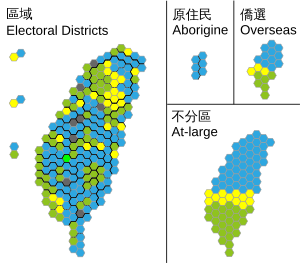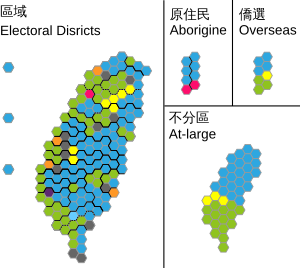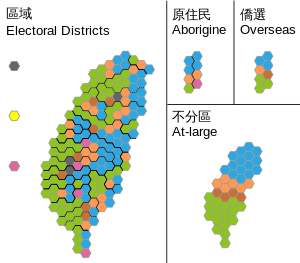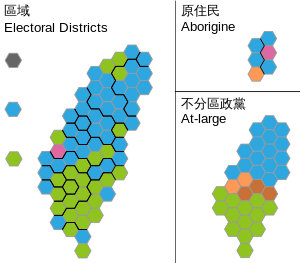User:Sleepingstar
Presidential election maps of Taiwan[edit]

Hexagonal cartograms of parliamentary elections of Taiwan[edit]
During the martial law period, Taiwan operated under a tricameral system, with parliamentary powers vested between the co-existing National Assembly, Legislative Yuan and the Control Yuan. However, with the democratisation process in the late 1980s and early 1990s, the Control Yuan was stripped off many of its former powers, and faded into the backdrop as its members were appointed rather than elected. Prior to 2005, elections of both the National Assembly and the Legislative Yuan were conducted via single non-transferable vote (SNTV), with multi-member districts. In 2005, the National Assembly elections were conducted under proportional representation (PR) for the first time, however, with the subsequent constitutional amendments, the National Assembly became fully defunct. In 2008, the Legislative Yuan also switched to its current supplementary member (SM) voting system.
Electoral maps need to balance three competing principles: shape preservation, topology preservation, and visual equalisation. However, each type of electoral maps faces limitations, and compromises need to be made to one or many of these guiding principles.
Traditionally, conformal electoral maps were frequently used due to their inherent ability to achieve shape preservation and topology preservation, and ease of representing voting distribution. However, a crucial blind spot of conformal electoral maps is their inability to balance visual equalisation: conformal electoral maps are frequently dominated by constituencies and divisions that are larger geographically, and tends to cause highly urbanised and popularised constituencies and divisions to fade into the backdrop owing to their smaller geographical size. This problem is particularly important in parliamentary elections, where often it is the distribution of seats that are more pertinent than voting distribution. It is also notoriously difficult to accurately portray seating distributions of multi-member districts on conformal electoral maps.
Hexagonal cartogram became popularised, especially during theUnited Kingdom general election of 2015, due to their ability to achieve visual equalisation of seating distribution, while retaining a moderate ability to preserve topology, albeit losing the ability to achieve shape preservation. Hexagonal cartogram also allows for seating distributions of multi-member districts to be accurately portrayed.
In consideration of the advantages and disadvantages discussed above, and also the complicated nature of seating distribution under the SNTV, PR and SM electoral systems in historical parliamentary elections of Taiwan, I decided to design a series of hexagonal cartograms, in the hopes of providing accurate depictions of the seating distributions of these elections.











